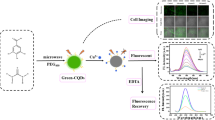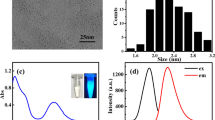Abstract
Copper is an important trace element involved in several physiological processes. The deficiency or excess of Cu in the human body may cause some serious diseases. EDTA has been widely employed in many industry fields owing to its excellent chelating ability. The poor biodegradability of EDTA makes itself a persistent substance in the natural environment. This work provided a fluorescence “on–off–on” strategy for the sequential determination of trace Cu2+ and EDTA. Amino-functionalized graphene quantum dots (afGQDs) were synthetized via the thermal pyrolysis of citric acid. Fluorescence resonance energy transfer (FRET) between afGQDs and 1-(2-pyridylazo)-2-naphthol (PAN) effectively quenched the fluorescence of this carbon-based nanomaterial. The generation of the Cu2+-PAN complex caused the increased FRET efficiency and the further fluorescence decline. The change of the fluorescence intensity sensitively responded to copper ions. The linear range and the limit of detection (LOD) were 1 nM-10 μM and 0.87 nM, respectively. EDTA could decompose the Cu2+-PAN complex and liberate PAN, which weakened the FRET efficiency and led to the fluorescence recovery. The increasing degree of the fluorescence intensity was closely related to EDTA within a concentration range from 10 nM to 10 μM with a LOD at 4 nM. Copper ions in the water and human serum samples and EDTA in the trypsin-EDTA sample were successfully detected based on the proposed fluorescence method.








Similar content being viewed by others
References
Kodama H, Fujisawa C, Bhadhprasit W (2012) Inherited copper transport disorders: biochemical mechanisms, diagnosis, and treatment. Curr Drug Metab 13:237–250
Rusjan D (2012) Copper in horticulture. In: Dhanasekaran D (ed) Fungicides for plant and animal diseases. InTech, Rijeka, pp 257–278
Ellingsen DG, Horn N, Aaseth J (2007) Chapter 26-Copper. In: Nordberg GF, Fowler BA, Nordberg M, Friberg LT (eds) Handbook on the toxicology of metals, 3rd edn. Academic Press, Burlington, pp 529–546
Tran VT, Tran NHT, Nguyen TT, Yoon WJ, Ju H (2018) Liquid cladding mediated optical fiber sensors for copper ion detection. Micromachines 9:471
El-Zomrawy AA (2018) Selective and sensitive spectrophotometric method to determine trace amounts of copper metal ions using Amaranth food dye. Spectrochim Acta A 203:450–454
Xu Z, Deng P, Li J, Tang S (2018) Fluorescent ion-imprinted sensor for selective and sensitive detection of copper (II) ions. Sensors Actuators B Chem 255:2095–2104
Amjadi M, Manzoori JL, Hallaj T, Azizi N (2017) Sulfur and nitrogen co-doped carbon quantum dots as the chemiluminescence probe for detection of Cu2+ ions. J Lumin 182:246–251
Baghban N, Yilmaz E, Soylak M (2017) Nanodiamond/MoS2 nanorod composite as a novel sorbent for fast and effective vortex-assisted micro solid phase extraction of lead(II) and copper(II) for their flame atomic absorption spectrometric detection. J Mol Liq 234:260–267
Wang W, Zhou X, Wu S, Li S, Wu W, Xiong Z, Shi W, Tian X, Yu Q (2019) Reusable surface plasmon resonance sensor for rapid detection of Cu2+ based on modified-chitosan thin film as an active layer. Sensors Actuators B Chem 286:59–67
Wei Z, Sandron S, Townsend AT, Nesterenko PN, Paull B (2015) Determination of trace labile copper in environmental waters by magnetic nanoparticle solid phase extraction and high-performance chelation ion chromatography. Talanta 135:155–162
Kobayashi K, Katsuya Y, Abdulah R, Koyama H (2007) Rapid and direct determination of selenium, copper, and zinc in blood plasma by flow injection inductively coupled plasma-mass spectrometry. Biol Trace Elem Res 115:87–93
Flores E, Pizarro J, Godoy F, Segura R, Gómez A, Agurto N, Sepúlveda P (2017) An electrochemical sensor for the determination of cu(II) using a modified electrode with ferrocenyl crown ether compound by square wave anodic stripping voltammetry. Sensors Actuators B Chem 251:433–439
Wang J, Yu J, Kong X, Hou L (2013) Spectrophotometric determination of EDTA in aqueous solution through ferroin formation using sodium sulfite as the reducer. Chemosphere 91:351–357
Oviedo C, Rodríguez J (2003) EDTA: the chelating agent under environmental scrutiny. Quim Nova 26:901–905
Zhao C, Pan Y, Su Y, Zhang Z, Guo Z, Sun L (2003) Determination of EDTA species in water by square-wave voltammetry using a chitosan-coated glassy carbon electrode. Water Res 37:4270–4274
Laamanen PL, Mali A, Matilainen R (2005) Simultaneous determination of DTPA, EDTA, and NTA by capillary electrophoresis after complexation with copper. Anal Bioanal Chem 381:1264–1271
Kari FG, Giger W (1996) Speciation and fate of ethylenediaminetetraacetate (EDTA) in municipal wastewater treatment. Water Res 30:122–134
Krokidis AA, Megoulas NC, Koupparis MA (2005) EDTA determination in pharmaceutical formulations and canned foods based on ion chromatography with suppressed conductimetric detection. Anal Chim Acta 535:57–63
Chiumiento F, Aloise A, Marchegiani F, Melai V (2015) Determination of EDTA in feed and premix formulations by HPLC-DAD. Food Chem 175:452–456
Andrade CEO, Oliveira AF, Neves AA, Queiroz MELR (2016) A new spectrophotometric method for determination of EDTA in water using its complex with Mn(III). Spectrochim Acta A 168:253–257
Zarouila YT, Miron MD, Capitan-Vallvey LF (2007) Disposable chemiluminometric sensor for rapid determination of EDTA. Microchim Acta 157:63–71
Fang B, Liang Y, Wu T, Chang L, Zhou Q, Chen F (2013) Determination of ethylenediaminetetraacetic acid base on the reversion of fluorescence quenching of 2-pyridinecarbaldehyde-p-phenyldihydrazone by ferric iron. Spectrochim Acta A 116:440–445
Cha C, Shin SR, Annabi N, Dokmeci MR, Khademhosseini A (2013) Carbon based nanomaterials: multifunctional materials for biomedical engineering. ACS Nano 7:2891–2897
Kalluri A, Debnath D, Dharmadhikari B, Patra P (2018) Chapter twelve graphene quantum dots: synthesis and applications. Method Enzymol 609:335–354
Shen J, Zhu Y, Yang X, Li C (2012) Graphene quantum dots: emergent nanolights for bioimaging, sensors, catalysis and photovoltaic devices. Chem Commun 48:3686–3699
Sun H, Gao N, Wu L, Ren J, Wei W, Qu X (2013) Highly photoluminescent amino-functionalized graphene quantum dots used for sensing copper ions. Chem Eur J 19:13362–13368
Achadu OJ, Nyokong T (2017) Graphene quantum dots anchored onto mercaptopyridine-substituted zinc phthalocyanine-au@Ag nanoparticle hybrid: application as fluorescence “off-on-off” sensor for Hg2+ and biothiols. Dyes Pigments 145:189–201
Toloza CAT, Khan S, Silva RLD, Romani EC, Larrude DG, Louro SRW, Júnior FLF, Aucélio RQ (2017) Photoluminescence suppression effect caused by histamine on amino-functionalized graphene quantum dots with the mediation of Fe3+, Cu2+, Eu3+: application in the analysis of spoiled tuna fish. Microchem J 133:448–459
Huang S, Wang L, Huang C, Su W, Xiao Q (2017) Label-free and ratiometric fluorescent nanosensor based on amino-functionalized graphene quantum dots coupling catalytic G-quadruplex/hemin DNAzyme for ultrasensitive recognition of human telomere DNA. Sensors Actuators B Chem 245:648–655
Huang S, Wang L, Huang C, Su W, Xiao Q (2016) Amino-functionalized graphene quantum dots based ratiometric fluorescent nanosensor for ultrasensitive and highly selective recognition of horseradish peroxidase. Sensors Actuators B Chem 234:255–263
Liu J, Chen Z, Tang D, Wang Y, Kang L, Yao J (2015) Graphene quantum dots based fluorescent probe for turn-on sensing of ascorbic acid. Sensors Actuators B Chem 212:214–219
Pan D, Zhang J, Li Z, Wu M (2010) Hydrothermal route for cutting graphene sheets into blue-luminescent graphene quantum dots. Adv Mater 22:734–738
Acknowledgments
This work was supported by the Opening Fund of Key Laboratory of Chemical Biology and Traditional Chinese Medicine Research (Ministry of Education of China), Hunan Normal University (KLCBTCMR201705) and the Open Sustentation Fund of State Key Laboratory of Chemo/Biosensing and Chemometrics, Hunan University (2017004).
Author information
Authors and Affiliations
Corresponding author
Additional information
Publisher’s Note
Springer Nature remains neutral with regard to jurisdictional claims in published maps and institutional affiliations.
Rights and permissions
About this article
Cite this article
Jiang, X., Kou, Y., Lu, J. et al. Fluorescence “on-off-on” Assay of Copper Ions and EDTA Using Amino-Functionalized Graphene Quantum Dots. J Fluoresc 30, 301–308 (2020). https://doi.org/10.1007/s10895-020-02497-z
Received:
Accepted:
Published:
Issue Date:
DOI: https://doi.org/10.1007/s10895-020-02497-z




